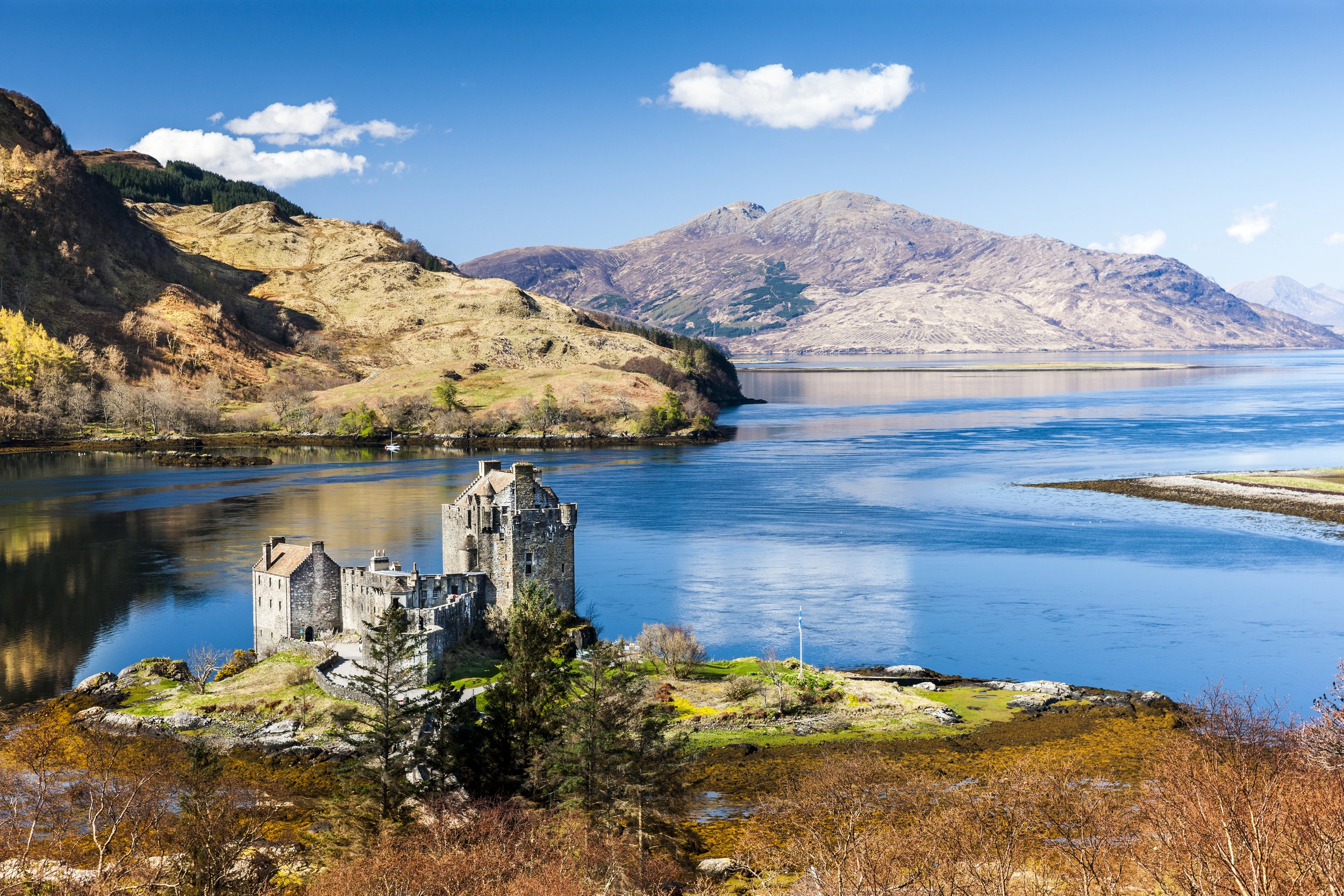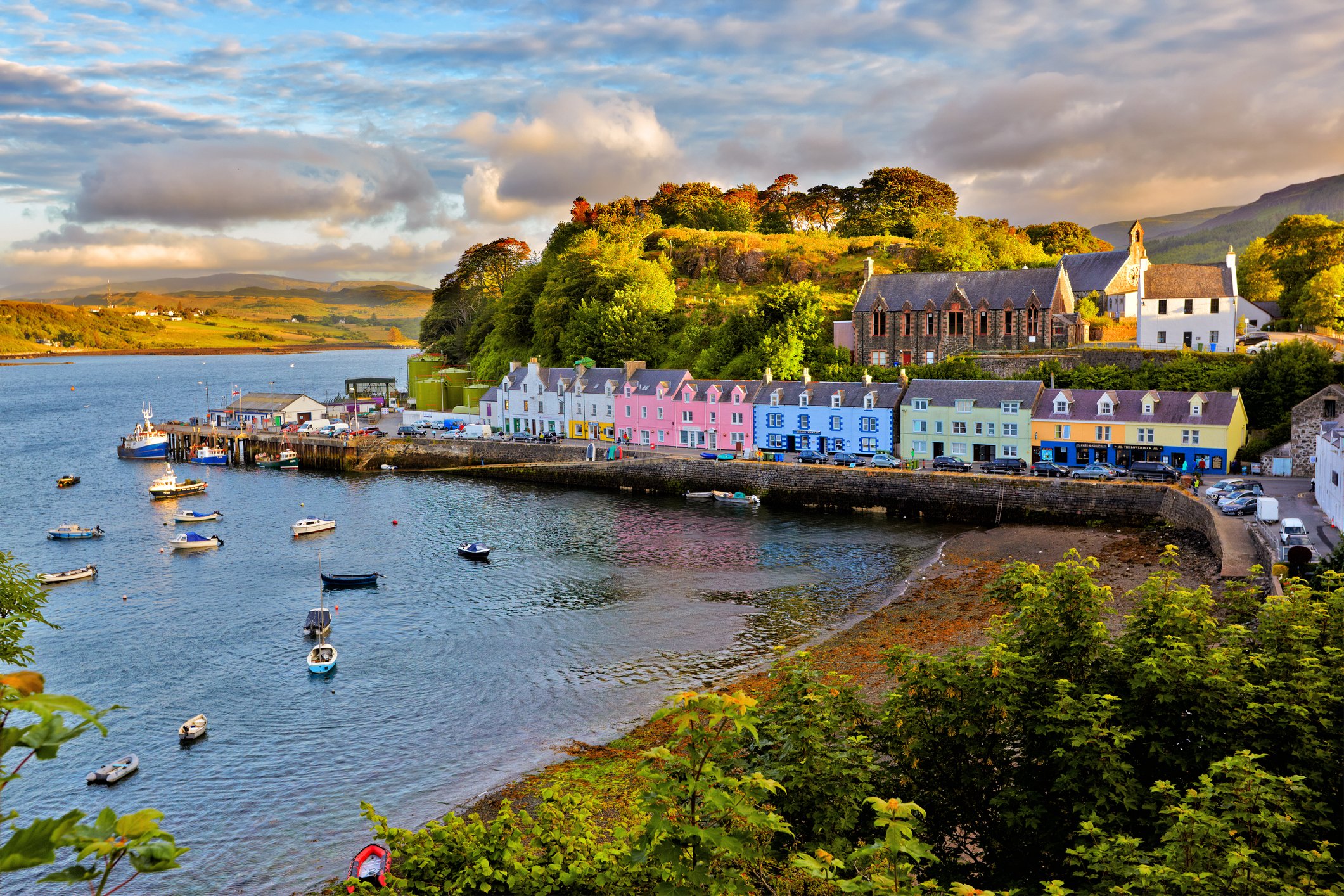Scotland: From Edinburgh to the Isles
“Scotland is a land of mountains, glens, and islands, a land of myth and legend”
So wrote Sir Walter Scott and indeed, with its untamed natural beauty, from the deep lochs of the highlands to the vast green meadows of the lowlands, and the rugged Hebridean Isles, Scotland has an almost ethereal quality.
Just as the unique terrain captures the imagination, so too do the cairns and ancient stone henges, fort ruins, battle sites, castles and medieval cities - all of which attest to the centuries of Pictish and Celtic tribes, Roman legions, Vikings, medieval kings, Clans, and Jacobites who have shaped Scotland’s identity. Interwoven with its history is the rich tradition of folklore and mythology, with tales of Gods and Giants, Kelpies, and Fairies, epitomised by Scotland’s national symbol, the mythical Unicorn.
Edinburgh
But Edinburgh is a mad god’s dream
Fitful and dark, unseizable in Leith
And wildered by the Forth, but irresistibly at last
Cleaving to sombre heights of passionate imagining
Till stonily, from soaring battlements,
Earth eyes Eternity- Hugh MacDiarmid
Calton Hill, Edinburgh
Known to the Romans as Alauna, the Celts as 'Din Eidyn' and finally by the blend of the Celtic ('edin') and the Anglo Saxon ('burgh'), Edinburgh lies off the east coast of Scotland on the south bank of the Firth of Forth. The historical, cultural, and political capital, Edinburgh has withstood the centuries, surviving battles, sieges, sackings, and military uprisings, and has been the setting for some of the most defining events in Scottish history.
Nestled between volcanic ridges and hollows above the skyline of gothic spires, stone towers, domes, and steeples, Edinburgh is a tale of two cities and dual personalities: the elegant Georgian New Town with manicured gardens and neoclassical buildings, and the medieval Old Town. The ancient castle atop a volcanic rock - ‘the crag’ - reigns above both parts of the city, as it leads down to softer bedrock, creating a “tail” which stretches into the medieval cobblestoned spine of the old town, known as the Royal Mile.
Edinburgh Castle
Linking Edinburgh Castle to Holyrood House and Arthur’s Seat, the Royal Mile and its narrow wynds are wonderfully atmospheric and old worldly, where, likely accompanied by the haunting cadences of a piper busking on the corner, you descend down through the old town, catching a tantalising glimpse of the North Sea in the distance. The Mile is lined with dark stoned buildings housing charming shops, cozy and historic pubs, and the centuries’ old St Giles Cathedral, known as the architectural anchor of the city, finally ending at the gates of the sumptuous Holyrood Palace.
Holyrood Palace, Edinburgh
Long before the Kingdom of Scotland existed, modern day Edinburgh had been shaped over the centuries by Romans, Celtic Tribes, and Saxons, and began to flourish from the 12th century onwards, during the reigns of successive medieval Scottish Kings. King Robert the Bruce, “Braveheart”, first granted Edinburgh a charter confirming its privileges as a royal burgh in 1329, which saw the city grow in importance as a major centre of trade. After the assassination of James I in the original capital of Scone in 1437, the seat of power moved to Edinburgh, and by the reign of James IV in 1488, who was a great patron of the arts and a prolific builder, Edinburgh had become a hub of European Renaissance culture, beginning with the renovation of Edinburgh Castle, the construction of Holyrood Palace, and the establishment of Scotland’s first printing press.
Ruthven printing press, invented by John Ruthven of Edinburgh from 1819 to 1822
By the 18th century however Edinburgh suffered from overcrowding and was restricted by its geographic location. The city expanded skywards, with the buildings along the mile reaching up to 14 stories high, the wealthiest enjoying the top floors, and the poorer at ground level. Unable to sustain the population, the streets of Edinburgh ran with sewerage, crime and corruption was rampant, and the amount of smoke pollution which hung over the city earned it the nickname “Auld Reekie’.
Victoria Street in the Old Town of Edinburgh
The New Town was built to ease the pressure in the late 18th century, following the natural contours of the land, with a simple axial grid, and a principal thoroughfare along the volcanic ridge linking two major garden squares. Today, both halves of the city are a delight to wander, the old town full of dark sandstone buildings, winding alleys, medieval churches, buildings of parliament, and the glorious Palace of Holyrood and Castle, while the New Town is full of symmetrical streets, elegant squares, and graceful terraces which epitomise the architectural ideals of the Enlightenment. Regardless of which one you might prefer, Edinburgh’s past remains an integral part of its present.
The Highlands
“In no other country does Nature exhibit herself in more various forms of beauty and sublimity than in the Highlands of Scotland … There, indeed, all objects are on so vast a scale, that we are for a while astonished as we gaze on the gigantic … but on recovering … that faculty everywhere recognises in those mighty mountains of dark forests, glittering glaciers, and regions of eternal snow – infinite all – the power and dominion of the sublime”
- John Wilson, 1875
Glencoe, Scottish Highlands
So much of what we love about Scottish culture -Tartans, Bagpipes, Scottish Clan history - are actually a part of Highland culture, and the Highlands is the Scotland of movies like Braveheart, The Highlander, and Skyfall, and the series Outlander. The distinction between Highland and Lowland Scotland is rooted in a complex history: Gaelic tribes once lived in the Highlands while the Scots lived in the lowlands, with the Great Glen as the natural dividing line between contrasting geographic, linguistic, and even cultural dimensions.
The gateway to the Highlands is undoubtedly Inverness, located in the Great Glen along the River Ness from which it gets its name, Inverness, meaning “Mouth of the river Ness”. The history of the city dates back to the 12th century, its charming centuries’ old architecture reflecting its rich and at times, dramatic past. The sprawling green landscape blends perfectly with the prominent historic buildings and ornate facades lining the banks of the river, from Inverness’ 11th-century castle rising above the city, and beautifully preserved Victorian Markets, to its grand cathedral, modelled after Notre Dame in Paris.
Inverness, where the River Ness meets the Moray Firth
From Inverness it is a short trip to the most famous whiskey region - Speyside. While whiskey, that most sacred tipple of Scotland, can be found right across the country, the Highlands are part of the whisky “golden triangle”, with Speyside taking its name from the river Spey, as most distilleries draw their water from its tributaries, such as the Fiddich, the Livet and the Avon. Distilleries such as Glenlivet, Glen Fiddich and Macallan have perfected the art over the centuries, as much a part of the fabric of Scotland’s story as its landscape.
Single malt scotch whisky on the seashore
The highlands are intrinsically linked with Scottish Clan culture, home to clans such McGregor, Campbell, Mackintosh, Fraser, MacKenzie, Macdonald, Macleod and Mackay among others, and their historic imprints can be felt in the powerfully emotive and atmospheric battle site of Culloden Moor and the picturesque yet haunting Glencoe.
Mountain landscape of Glencoe
This fascinating history is part of the magnificent castles which punctuate the landscape. The 14th-century Cawdor Castle is an impressive stone medieval tower built around an ancient holly tree by the Thanes of Cawdor, a family made famous by Shakespeare's "MacBeth” but also the ancestral home of Clan Campbell.
Cawdor Castle, Nairn
Just south of Inverness is Scotland’s most famous Loch, Loch Ness, steeped in myth and folklore, as is the thousand-year-old Urquhart Castle on the bank above the Loch. The magnificent ruins, set against the dramatic backdrop of the Great Glen, played a part in the 13th-century Wars of Independence and witnessed Clan MacDonald, Lords of the Isles, struggle with the Scottish Crown for power.
Urquhart Castle, Loch Ness
Across to the coast, at the gateway to the Inner Hebrides and the north-west Highlands of Scotland, sits the breathtaking Eilean Donan Castle, perhaps the most photographed castle in Scotland and once owned by Clan Mackenzie, perched on a tidal island at the meeting point of three lochs, gazing out across to the Isle of Skye.
Eilean Donan, Kyle of Lochalsh
The Hebrides
“From the lone sheiling of the misty island
Mountains divide us, and the waste of seas -
Yet still the blood is strong, the heart is Highland,
And we in dreams behold the Hebrides."-Anonymous
View Over Old Man Of Storr, Isle Of Skye
Scotland has over 790 islands, 94 being recorded as inhabited, and each one enjoys a distinctive landscape and history. Arguably the most famous and the largest, the Isle of Skye, is a land of jagged peaks and rocky outcrops overlooking the sea, sweeping green valleys at the foot of the Soaring Cuillin Hills, and fairy-tale waterfalls.
Portree is the charming main town, lined with brightly coloured facades of buildings along the harbourfront. The Isle is home to Dunvegan Castle, one the greatest Hebridean castles and the only Highland fortress to have been continuously occupied by the same family, the Macleods, for 800 years. Skye’s history is thus intertwined with ancient clan wars, Jacobite Risings and the Highland Clearances.
Portree, Isle of Skye
The landscape shifts as you move further south to the Isle of Mull, the second largest of the Inner Hebrides, accessible by ferry from the seaside town of Oban, perched on an almost perfect horseshoe bay in the Firth of Lorn. Mull is loved for its wild coastal scenery and silver sandy beaches (though perhaps not for swimming), but it is also the main point of departure to the tiny yet famous Isle of Iona, just off the west coast.
Ben More on the Isle of Mull
Iona’s history began when St Columba arrived in 563 CE, built his first Celtic church, and established a monastic community. Iona became the sacred isle, where 48 Kings of Scotland are buried in the ancient roman church, and from Iona, the monks who followed St Columba converted most of pagan Scotland and northern England to the Christian faith, making it one of the most important places in Scotland.
Isle of Iona
It is difficult to do justice to all the wonders of Scotland, and every time I visit I feel as if I am reaching through the centuries, rediscovering it as if for the first time. It is little wonder that for centuries, poets, artists musicians and writers have spent their lives trying to capture its essence.
TOUR SCOTLAND
HISTORY & HERITAGE FROM EDINBURGH TO THE ISLES
Led by historian Dr Lauren Mackay, this new 18-day tour will take us through key regions of Scotland as we wind back the centuries.
From our unique and perfectly situated hotels in Pitlochry, Inverness, the Isle of Skye, Knipoch, and Edinburgh, we will tour some of Scotland’s most beautiful castles and palaces, marvel at ancient cairns and standing stones, traverse the cobblestoned streets of its medieval cities, visit the famed Isles of Skye, Mull, and Iona, and sample that most sacred element of traditional Scottish culture – whisky.

















